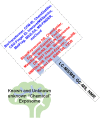The Chemical Exposome of Human Aging
- PMID: 33329714
- PMCID: PMC7732411
- DOI: 10.3389/fgene.2020.574936
The Chemical Exposome of Human Aging
Abstract
Aging is an inevitable biological phenomenon displayed by single cells and organs to entire organismal systems. Aging as a biological process is characterized as a progressive decline in intrinsic biological function. Understanding the causative mechanisms of aging has always captured the imagination of researchers since time immemorial. Although both biological and chronological aging are well defined and studied in terms of genetic, epigenetic, and lifestyle predispositions, the hallmarks of aging in terms of small molecules (i.e., endogenous metabolites to chemical exposures) are limited to obscure. On top of the endogenous metabolites leading to the onset and progression of healthy aging, human beings are constantly exposed to a natural and anthropogenic "chemical" environment round the clock, from conception till death, affecting one's physiology, health and well-being, and disease predisposition. The research community has started gaining sizeable insights into deciphering the aging factors such as immunosenescence, nutrition, frailty, inflamm-aging, and diseases till date, without much input from their interaction with exogenous chemical exposures. The "exposome" around us, mostly, accelerates the process of aging by affecting the internal biological pathways and signaling mechanisms that result in the deterioration of human health. However, the entirety of exposome on human aging is far from established. This review intends to catalog the known and established associations of the exposome from past studies focusing on aging in humans and other model organisms. Further discussed are the current technologies and informatics tools that enable the study of aging exposotypes, and thus, provide a window of opportunities and challenges to study the "aging exposome" in granular details.
Keywords: aging; exposome; informatics; mass spectrometry; metabolite; model; pollution; telomere.
Copyright © 2020 Misra.
Figures



References
Publication types
LinkOut - more resources
Full Text Sources
Miscellaneous

